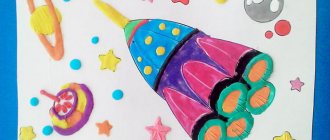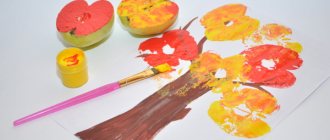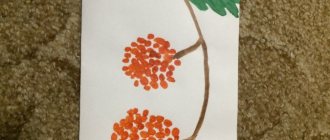The importance of modeling for the development of a child
The benefits of modeling for children are enormous. These activities have a good effect on the child’s nervous system, fine motor skills of the hands are trained, spatial thinking is formed, the child learns the shape of objects and their colors. It has a beneficial effect on the emotional and mental state of the child. With the help of modeling, a child can create his own world as he sees and feels it.
Modeling is one of the most popular types of creativity, in which the child uses his sense of touch to the maximum. He creates something of his own, and not only sees it, but also touches it, holds it in his hands, and can change it if necessary.
Thanks to modeling, the mental development of the child occurs, it affects the health and emotional state of the baby, and helps the development of personality.
Modeling has the following effects on the development of a child:
Modeling and spatial thinking
- increases sensitivity, helps to sensory perceive shape, weight, texture, color
- forms spatial, figurative and abstract thinking, stimulates imagination
- the child learns to feel, evaluate correctly, see the objects around him and the living world from a different angle, and find solutions in hopeless situations
Modeling and the development of fine motor skills and speech in children
trains fine motor skills, which in turn takes an active part in the development of speech, affects coordination of movements, trains memory and helps the child think logically
Modeling and synchronizing the child's brain
helps synchronize actions with both hands
leads to strengthening the connection between the hemispheres of the brain, due to which attention develops
Developing creativity through sculpting
- the child learns perseverance and patience, to be careful
- children learn to concentrate, make plans and carry out what is planned, compare what is planned with the result obtained, and make changes if necessary
- aesthetic taste develops
- develops a child’s sense of self-worth and gives confidence in their abilities
- the child learns to experiment and make new discoveries
- through modeling, a child can express, in a way accessible to him, his emotions, both positive and negative
In addition, constant practice of such calm games as modeling normalizes sleep, helps calm an overly active baby, reduces excitability, the child becomes calmer and less likely to get irritated.
Modeling from plasticine for children 3-4 years old
For children under 4 years old, you can offer simple tasks:
- make a sun , to do this, stick a yellow round cake on blue cardboard, and smear small pieces of plasticine, making rays
- make grass by smearing green pieces of dough, plant flowers by crushing colorful flower-shaped balls on cardboard
- make needles on the already drawn hedgehog, also smearing the plasticine
- make multi-colored fireworks in the sky (on dark blue cardboard)
- balls and garland on it
- make autumn leaves on a tree and show how they fall
- make snowflakes in the sky or rain
- Older children can create more complex works, mix techniques, for example, add natural material to the picture, can work on details, correct or create something using stacks
- They can make plot pictures, depict animals and flora in detail, and add several characters. The older the child, the more opportunities and skills he has that he uses in creativity, the more difficult work he can be offered
- After such work, it is important to support the child and invite him to come up with a story together about what he drew. This will help the development of speech and facilitate the child’s communication with peers.
- Encourage your child for any successes and encourage them if they fail. It is important to select tasks according to age. If he copes with the task, this will instill self-confidence in the child, bring pleasure from creativity, and he will be happy with his results. Such work will bring maximum benefit and satisfaction to both the child and the parents.
How to learn to sculpt from plasticine, dough or clay?
- You don’t think that when you give a child plasticine, he will immediately create something specific? He will probably taste it first, knock it on the table, and put it among his toys. You need to teach your baby how to use plasticine for its intended purpose.
- The first thing you need to do is interested . There is no need to persuade him or force him, he must want it himself. To do this, start working with plasticine yourself and your child will become interested.
- First, buy soft plasticine or modeling dough, or you can make it yourself, see the recipe above. With soft material, the child will work more willingly, because he will be able to
- Pieces . This is the first thing you need to show your baby how to tear off a piece and stick it back. You can turn everything into a game: feed the cow by tearing pieces from green plasticine. You can sculpt a torn piece onto cardboard, or, for example, onto a drawing of a Christmas tree, as if decorating it
Making balls and sausages
Balls and sausages . Show your child how to make balls from plasticine, and then you can have fun crushing them or making a snowman out of them. Make sausages between your palms or by running your palm across the table, you can then make a ring out of it or twist it into a spiral
Flat modeling from plasticine
Flattening is a very exciting activity, because with its help you can make a roof for a house, ears for a dog. You can stick the flattened pieces to the paper, thus complementing the design
Smearing plasticine
Smudging . This is also a very necessary technique. Do this first on a board for working with plasticine, then you can “draw” like this on paper.
Prints on plasticine
Prints . Children will definitely enjoy this entertainment. Print something on flattened plasticine, for example, with a figurine from a sorter, or walk with the legs of a toy animal
Plasticine vase
Sticking . Show your child how to cover some container, such as a glass, with plasticine, and press beads on top. You will get a beautiful vase. For the little ones, you can make animal figures from cardboard and offer to sculpt plasticine on them.
These simple tips will help you introduce your child to plasticine. But the main thing in such classes is a good mood. Modeling should first and foremost be fun.
How to sculpt with a baby?
When working with plasticine or other materials for modeling, you must be close to the child, and not only monitor his work, but also sculpt with him.
You shouldn’t expect much from the baby; he is just beginning his acquaintance with new material. Choose activities according to the child's age.
Choosing the color of plasticine
Let your child choose a color, just don’t offer many options, two are enough.
Do not impose your opinion on him; it may not coincide with the child’s preferences.
How to knead plasticine?
Start kneading the material, you are your piece, the child is yours, let him see what you are doing and try to repeat it himself. When the plasticine is ready, you can start sculpting.
Where to start sculpting?
Simple tasks, to begin with, will be enough for the child to become interested in this type of creativity. Let him pinch off a piece and show him how to make a cake out of it. There are plenty of simple ideas for what you can do with plasticine, and some of them are described below.
Materials for modeling
There are several materials with different properties that are suitable for sculpting. They are all good in their own way and they all have their shortcomings.
Children's plasticine
Plasticine for modeling needs to be chosen correctly, because a very hard child will not be able to knead it and it will fall apart in his hands, and a very soft one will stick to everything and it will be very difficult to make anything out of it.
Do not buy plasticine with a fruity smell for your kids, otherwise the child will try to taste it instead of modeling it.
From imported companies we can recommend JOVI plasticine, it is quite soft and made from a natural plant base. This plasticine contains rice and wheat flour, starch and natural dyes. Everything that this company produces is safe and meets the international standard ISO 9002. Plasticine from KOH-I-NOOR and Crayola is also good for children.
Wax plasticine
This is a new type of plasticine that is suitable for small children because it is softer and more flexible. It is made on a wax base, so it is safe for children. Its pieces stick well to each other and it is easy to work with small, fragile hands.
This plasticine is great for plasticineography, read about it below.
Modeling clay
Clay has been used for modeling for many years and children work with it with pleasure, although they have to wash their hands thoroughly afterwards.
Clay is sold in powder form and can be diluted with water at home. If you don't want to bother with this, there is clay already available.
This material is good because of its low cost and you can give a child a lot of it, let him build a big castle or bridge, such entertainment will not put a dent in the parents’ pockets.
Clay can also be used for drawing, especially with young children. Just dilute it with more water and pour it onto some flat surface. That's it, now you can draw with your fingers or a stick, or whatever you want.
There are also ready-made kits for creativity with clay, for example, for making dishes, they also contain a pottery wheel.
If you want to leave a clay craft as a souvenir, it needs to be fired at a temperature of 900°C for a couple of hours. If you don’t do this, then the craft will, of course, dry out, but it will be fragile and crumble at the first opportunity. You can also coat it with PVA glue, it will give the craft a little strength.
Modeling paste
It's something like a mixture of plasticine and clay, something like natural clay. This paste is pleasant to knead in your hand; it is plastic, soft, and very similar to clay when working. But it has one advantage - it does not need to be baked, it hardens on its own. Because It is available only in white or terracotta color; it can be painted after hardening and opened with a clear varnish.
The modeling paste is intended for use with children aged 3 years and older.
Play dough
Salted play dough can be bought ready-made in the store or made yourself. See the recipe for this test below.
This material is great for very young children because it is very easy to work with. A child can sculpt from unpainted dough and then paint it with paints. There is dough already with dyes, but there are not so many colors, although for kids 4 colors are enough so that the variety of colors does not distract the baby from modeling. If you want to save the craft, just leave it for a while and it will dry and harden on its own.
Play dough recipe
This recipe produces a dough very similar to the famous Play Doh brand. It is very soft, does not stick to your hands, it can be stored and used for a long time, and it only takes a few minutes to prepare it.
For the test you will need:
- 1 tbsp. white flour
- 1/2 tbsp. fine salt
- 1 tbsp. any vegetable oil
- 2 tsp citric acid
- a little water, up to 1/2 cup
- any food coloring
Pour all the dry ingredients into the pan and mix thoroughly, then add the vegetable oil. Place the pan on the stove over medium heat, add dye to the water and pour it into the pan in a slow stream, stir constantly until thickened, the mass should become homogeneous. When you stir, the mass will pull away from the walls and bottom of the pan and turn into one lump. When this happens, take the dough out and place it on a floured surface.
This amount of ingredients will make a ball of play dough the size of a large fist.
You can store it in the refrigerator, pre-wrapped in cling film, or in a plastic container with a lid. Before working with the dough, you need to knead it a little in your hands and it will be ready.
Modeling mass
This material is very pleasant to the touch, with a velvety texture, light and soft. This mass stretches well, but does not stick. If you mix pieces of different colors, you get a new color or shade. It does not require baking and dries itself in 6-8 hours in the air.
It also has an interesting property of recovering if it has not dried completely. It can be moistened with water, for example, by spraying it from a spray bottle or wrapping it in a wet piece of cloth, and then seal it hermetically for a while. Thanks to this, a craft made from this material can be corrected or some changes made.
However, the modeling compound has a serious drawback - its price; it is not rational to buy it for children; it is good just for smaller and more detailed work.








